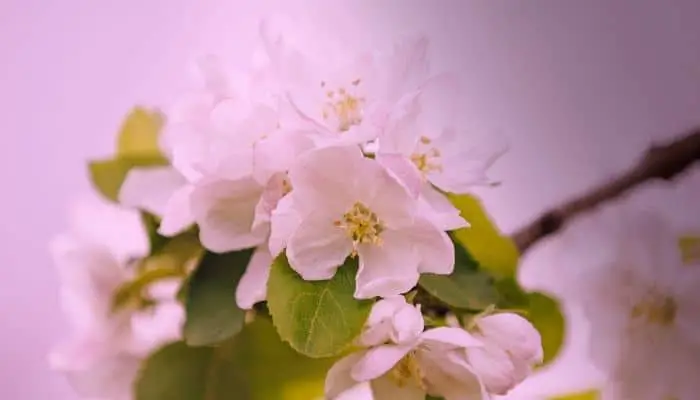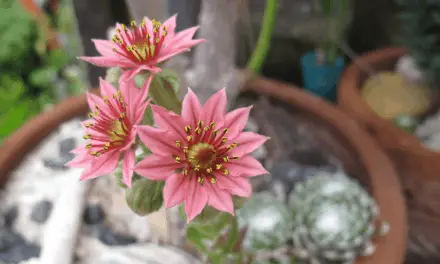Lilacs live to be about 100 years old and are a staple in many gardens because of how easily they grow.
They are beautiful, sweet-smelling, and are usually one of the first plants to bloom in mid to late spring.
But occasionally, some lilac growers are stumped to see their plant blooming in the fall.
In this article, we are going to get to the bottom of why this happens and how you can get yours to flower in the spring.
Table of Contents
Why Is My Lilac Bush Blooming in the Fall?

Your lilac bush is blooming in the fall because it has come under some type of stress during the summer and has then experienced a mild beginning of winter.
Lilacs set their flower buds in summer and bloom in the springtime.
But stressful events, such as drought and damage from the wind, can cause them to bloom in the fall.
For example, your lilac may go into a dormant state during the summer because of drought. It may then revive later in the year when it receives some moisture and begins to bloom.
When they come back to life from a dormant state they often bloom, even though freezing weather may just be around the corner.
It’s not fully understood why this happens but some experts believe that when the lilac revives from its dormant state, it fears that it’s dying and wants one last chance to reproduce.
This usually doesn’t affect the health of your lilac and just results in fewer blooms in the coming spring.
Also Read: Why Is My Lilac Bush Turning Brown? (And How To Revive It)
How To Get Your Lilac Bush To Bloom In The Spring
It’s usually not ideal for your lilac to bloom in the fall because frost may be just around the corner and it will also result in fewer flowers come next spring.
Here is a quick care guide to help you get your lilac bush to flower in the spring.
Give It Enough Sun
These plants grow best when they get at least six hours of sunlight each day.
While they can tolerate a few shady days here and there but your lilac bush needs to get plenty of regular full sun.
Getting enough sunlight will help to ensure that it blooms when it’s supposed to, in spring.
Lilac Bushes Like Moderate Amounts Of Water
If you are watering your lilac too often, the soil may end up being too wet.
Soggy soil can cause big problems for mature lilac bushes.
But when you first plant your lilac, be sure to water it regularly until its roots take hold and it can absorb enough water for its needs.
As it matures, it will require less watering.
Try to keep the soil slightly moist to get the most out of your lilac bush.
Test the top inch of soil with your finger and if it feels dry, you can give it some water.
And water the soil thoroughly so that plenty soaks in for the roots to absorb.
Lilacs Like Rich Soil
Is your soil dry or infertile?
This could be another contributing factor as to why your lilac bush is blooming in the fall.
Inspect your soil to see if it is benefiting your lilac bush or hindering it.
Lilac bushes grow best in well-drained soil that’s slightly alkaline and kept slightly moist.
They like soil with lots of organic matter with a pH in the range of 6.5 to 7.0.
A pH of less than 5.5 could stress your lilac and affect it when it blooms.
If the pH is too low, you may need to add lime to the soil to increase the level.
Extreme Weather Can Shock Your Lilac
As mentioned before, your lilac bush may bloom early because of shock due to severe weather conditions.
If the climate where you live is too hot or humid, your lilac may go dormant and this can lead to blooms in the fall.
These plants grow best in a place where the summers are more moderate.
They like 6 to 8 hours of direct sun, so be sure not to plant them where they’ll be in the shade for no more than 3 or 4 hours.
How To Encourage Your Lilac Bush To Bloom
You want your lilac bush to bloom as much as it can.
Pruning
One way to encourage this is to prune it once the blooming season is over.
Once the lilac is done blooming, you want to prune the dead branches to thin the bush out.
There are many benefits of pruning your flowering bushes.
Cutting off what is dead not only keeps the size of the bush in check but also promotes new growth the following year.
Watch For Pests
To keep your lilac bush healthy, ensure it is pest-free by checking the color and texture of its leaves.
It goes without saying, but certain insects can damage your bushes.
Use an insecticide you are comfortable with to keep these tiny pests away.
Watch For Diseases
Similar to checking for insects, you also want to make sure your lilac bush is free of disease.
Inspect its leaves thoroughly to ensure it is disease-free.
Fungal diseases on your bushes can appear as powdery-looking patches on the leaves.
If you detect damage from pests or disease in your lilac bush, treat it as soon as possible.
If you let the disease spread or the pests keep damaging the plant, it may affect when and how much your lilac will bloom.
Keeping your lilac bushes healthy will help them overcome their late bloom and get back to a normal flowering cycle.
While you can’t do much about the effects of environmental stress or fluctuating weather on your bushes, you can help keep them as strong as possible so they can return to regular blooming.
The most important thing to keep in mind is that a late-blooming lilac bush is nothing to worry about.
Even if it does not bloom the following spring, it can still get back on course with the right care.
Final Thoughts
The reason for your lilac bush blooming in the fall typically stems from the weather.
If you have been experiencing late bloom time for your lilac bushes, it may not be your fault.
You can’t do much about the weather, so If your plants are not doing so well, it may not be your fault.
If you live in a hot and humid climate, this could be the reason your lilacs aren’t at the top of their game.
Severe or stressful weather conditions can affect the bloom time of many plants.
But you can still take care of your lilac bushes so they bloom to their fullest potential.
Don’t worry, a fall-blooming lilac bush can eventually bloom in the spring.
Taking care of your lilac bush is a good way to set it back on track.




